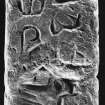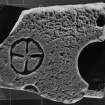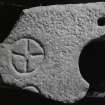Lochgoilhead 1
Inscribed Stone (Early Medieval), Ogham Inscribed Stone (Early Medieval)
Site Name Lochgoilhead 1
Classification Inscribed Stone (Early Medieval), Ogham Inscribed Stone (Early Medieval)
Alternative Name(s) Lochgoilhead Church
Canmore ID 318854
Site Number NN10SE 4.02
NGR NN 19851 01461
Datum OSGB36 - NGR
Permalink http://canmore.org.uk/site/318854
- Council Argyll And Bute
- Parish Lochgoilhead And Kilmorich
- Former Region Strathclyde
- Former District Argyll And Bute
- Former County Argyll
Lochgoilhead, Argyll, inscribed stone fragment
Measurements: L 0.42m, W 0.16m, D 0.12m max
Stone type: sandstone
Place of discovery: NN 1985 0146
Present location: in Lochgoilhead Church.
Evidence for discovery: found inside Lochgoilhead Church in the early 1990s, original findspot unknown.
Present condition: weathered and damaged.
Description
This small fragment bears inscriptions both in Latin letters and in ogham letters, and their interpretation is fraught with problems. It is also hard to define the purpose of the stone.
Date range: early medieval.
Primary references: Forsyth 1996, 374-84.
Desk-based information compiled by A Ritchie 2019.
Field Visit (September 1986)
(1) Fragment of an inscribed pillar of fine-grained sandstone, 0.42m long by 0.16m wide and tapering from115mm to 75mm in thickness. It is incomplete, although probably lacking only a short length, at the tapered end, while one face is extremely irregular and was probably never carved. Both edges (a, c) and the other face (b) are comparatively smooth, although the latter shows a marked change of level towards the left end, which is damaged, and part of its surface appears to have been subsequently cutaway, bearing several oblique knife-cuts. The remainder of face b bears two lines of irregular incised lettering varying in height from 35mm to 55mm. The first line begins with the erased area, followed by the miniscule letters B, D, E, and ?F, and the second line finishes L, M, N, all in alphabetic order. The two or three markings at the beginning of the second line are much damaged and appear to have been less regularly shaped, although that preceding the L may have been a K defaced by later incisions. The lower edge (c) is divided, 0.17m from the tapered left end, by a transverse groove of V section, and to the right of it there are at the top the small miniscule letters ?D and O, followed by larger but less regular markings, while there are also traces of two or three possible capital letters in the worn area to the left of the groove. The lower part of the right division bears an incised rectangular panel having a horizontal stem-line with groups of short transverse strokes projecting to both sides, provisionally identified as an ogam inscription. The top edge (a) is plain except for a transverse groove a little to the right of the oneon face c. These marks correspond to the change of level of face b, but the inscription on that face begins well to the leftof that point, and their significance is uncertain.
The sequence of letters in the main inscription (b) suggests that it was part of an alphabet, carved either for didactic or liturgical purposes, like that on the cross-marked pillar at Kilmalkedar (Co. Kerry), where the inscription is attributed to the 6th century (en.17*). In the present case, however, the date may be somewhat later. While the lettering on edge c may include the Irish word DO (‘for'), suggesting the use of the memorial formula OROIT DO... ('a prayer for...'), the other letters cannot be identified, and the ogam inscription awaits further study (en.18*).
RCAHMS 1992, visited September 1986
Reference (2001)
Church 'of the three holy brethren', incorporating considerable medieval fabric. Both stones are in the church.
(1) Fragment of pillar of sandstone, 0.42m by 0.16m and 75mm to 115mm thick; much worn and damaged by knife-cuts. One face (b) bears two lines of irregular incised letters in alphabetic order, including B, D, E, ?F and ?K, L, M, N. Edge (c) bears traces of other letters, although only DO are legible, and an ogham inscription composed of a horizontal stem-line 0.19m long with groups of short transverse scores. Dr K Forsyth suggests the reading [?h]MUD[?]ALI[?], which may represent an Irish personal name such as 'Mod-Magli' or 'Mu-Dali'. (Forsyth 1996, 374-84).
I Fisher 2001




















